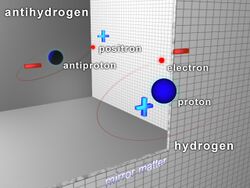| Display title | Physics:Antihydrogen |
| Default sort key | Antihydrogen |
| Page length (in bytes) | 21,361 |
| Namespace ID | 3020 |
| Namespace | Physics |
| Page ID | 395206 |
| Page content language | en - English |
| Page content model | wikitext |
| Indexing by robots | Allowed |
| Number of redirects to this page | 0 |
| Counted as a content page | Yes |
| Page image |  |
| HandWiki item ID | None |
| Edit | Allow all users (infinite) |
| Move | Allow all users (infinite) |
| Page creator | imported>Rtexter1 |
| Date of page creation | 05:26, 5 February 2024 |
| Latest editor | imported>Rtexter1 |
| Date of latest edit | 05:26, 5 February 2024 |
| Total number of edits | 1 |
| Recent number of edits (within past 90 days) | 0 |
| Recent number of distinct authors | 0 |
Description | Content |
Article description: (description)
This attribute controls the content of the description and og:description elements. | Antihydrogen (H) is the antimatter counterpart of hydrogen. Whereas the common hydrogen atom is composed of an electron and proton, the antihydrogen atom is made up of a positron and antiproton. Scientists hope that studying antihydrogen may shed light on the question of why there is more matter than... |

